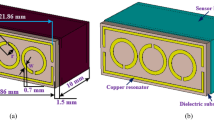Abstract
In daily life, people consume many liquids in their diet like water, soda, milk, juices, etc. Due to the growing demand of these liquids, many adulterants are being used in the market, which degrades the quality of the product and may be harmful to the human being’s health. For a human being, it is very difficult task to find out adulteration in the liquids that they are having in their daily diet. In order to resolve this problem, a device that is very easy to use and provides quick and accurate results is designed, where change in resonant frequency is the parameter used for adulteration detection. In this paper, a split ring resonator-based microwave sensor is proposed for the detection of adulteration in different fluids. The resonant frequency of the sensor is 9.24 GHz. The sensor design exhibit defected ground structure to obtain a sharp resonant frequency. The proposed sensor is fabricated and tested by using water and milk with adulteration (sugar, salt and soap). 2 µl drop of each fluid is placed on the sensor and a shift in resonant frequency from 9.24 to 7.3 GHz for water and 8.4 GHz for milk is noticed.










Similar content being viewed by others
References
Singh, V. R., Dwivedi, S. (1995). Ultrasonic detection of adulteration in fluid foods.In Proceedings of the first regional conference, IEEE engineering in medicine and biology society and 14th conference of the biomedical engineering society of India. pp. 1/73–1/74.
Subari, N., Saleh, J. M., Shakaff, A. Y. M., & Zakaria, A. (2012). A hybrid sensing approach for pure and adulterated honey classification. Sensors, 12(10), 14022–14040.
Fan, Y., Deng, X., Wang, Q., Wang, W. (2010). Testing glucose concentration in aqueous solution based on microwave cavity perturbation technique. In 3rd international conference on biomedical engineering and informatics. pp. 1046–1049.
Hayt, W. H., & Buck, J. A. (1989). Engineering electromagnetics (5th ed.). McGrawHill.
Shelkunoff, S. A., & Friis, H. T. (1966). Antennas: theory and practice (3rd ed.). Wiley.
Pendry, J. B., Holden, A. J., Robbins, D. J., & Stewart, W. J. (1999). Magnetism from conductors and enhanced nonlinear phenomena. IEEE Transactions on Microwave Theory and Techniques, 47(11), 2075–2084.
Torun, H., Top, F. C., Dundar, G., & Yalcinkaya, A. D. (2014). An antenna-coupled split-ring resonator for biosensing. Journal of Applied Physics, 116(12), 124701.
Selvaraju, R., Jamaluddin, M. H., Kamarudin, M. R., Nasir, J., & Dahri, M. H. (2018). Complementary split ring resonator for isolation enhancement in 5G communication antenna array. Progress In Electromagnetics Research C, 83, 217–228.
Sydoruk, O., Tatartschuk, E., Shamonina E., Solymar, L. (2008). Resonant frequency of singly split single ring resonators: An analytical and numerical study. In Presented at metamaterials, 2nd international congress on advanced electromagnetic materials in microwaves and optics.
Ahn, D., Park, J. S., Kim, C. S., Kim, J., Qian, Y., & Itoh, T. (2001). A design of the low-pass filter using the novel microstrip defected ground structure. IEEE Transactions on Microwave Theory and Techniques, 49(1), 86–93.
Liu, H. W., Li, Z. F., & Sun, X. W. (2003). A novel fractal defected ground structure and its application to the low-pass filter. Microwave and Optical Technology Letters, 39(6), 453–456.
Woo, D. J., Lee, T. K., Lee, J. W., Pyo, C. S., & Choi, W. K. (2006). Novel U-slot and V-slot DGSs for bandstop filter with improved Q factor. IEEETransactions on Microwave Theory and Techniques, 54(6), 2840–2847.
Verma, A., Bhushan, S., Tripathi, P. N., Goswami, M., & Singh, B. R. (2017). A defected ground split ring resonator for an ultra-fast, selective sensing of glucose content in blood plasma. Journal of Electromagnetic Waves and Applications, 31(10), 1049–1061.
Funding
None.
Author information
Authors and Affiliations
Corresponding author
Ethics declarations
Conflict of interest
The authors declare that they have no Conflicts of interest/competing interests.
Consent for Publication
Authors have given their consent for publication.
Additional information
Publisher's Note
Springer Nature remains neutral with regard to jurisdictional claims in published maps and institutional affiliations.
Rights and permissions
About this article
Cite this article
Bhushan, S., Kumar, S., Singh, N. et al. Defected Ground Split Ring Resonator-Based Sensor for Adulteration Detection in Fluids. Wireless Pers Commun 121, 1593–1606 (2021). https://doi.org/10.1007/s11277-021-08686-8
Accepted:
Published:
Issue Date:
DOI: https://doi.org/10.1007/s11277-021-08686-8




